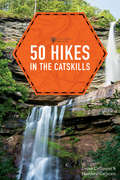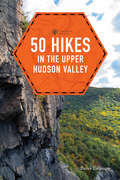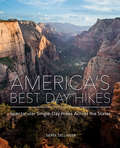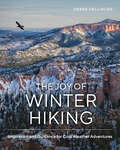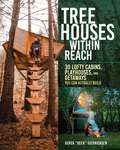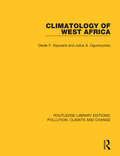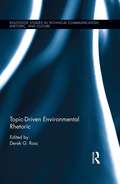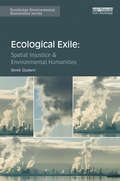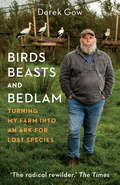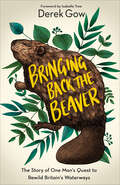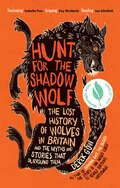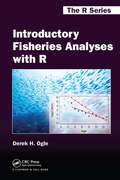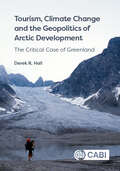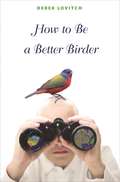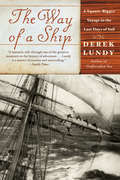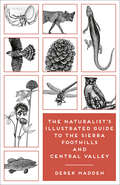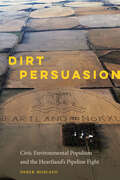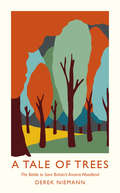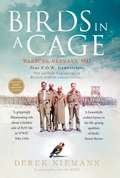- Table View
- List View
Ecology and Conservation of Estuarine Ecosystems
by Renzo Perissinotto Derek D. Stretch Ricky H. Taylor Renzo Perissinotto Derek D. StretchSt Lucia is the world's oldest protected estuary and Africa's largest estuarine system. It is also the centerpiece of South Africa's first UNESCO World Heritage Site, the iSimangaliso Wetland Park, and has been a Ramsar Wetland of International Importance since 1986. Knowledge of its biodiversity, geological origins, hydrology, hydrodynamics and the long history of management is unique in the world. However, the impact of global change has culminated in unprecedented challenges for the conservation and management of the St Lucia system, leading to the recent initiation of a project in support of its rehabilitation and long-term sustainability. This timely volume provides a unique source of information on the functioning and management of the estuary for researchers, students and environmental managers. The insights and experiences described build on over 60 years of study and management at the site and will serve as a valuable model for similar estuaries around the world.
50 Hikes in the Catskills (Explorer's 50 Hikes #0)
by Derek Dellinger Matthew CathcartThe essential guide to hiking the majestic Catskill Mountains With soaring mountain tops and wide-ranging trails, the Catskills offer a truly special hiking experience to travelers of all kinds. Catskill veterans Derek Dellinger and Matthew Cathcart explore trails for every level of hiker, from the gentle but breathtaking slog up Slide Mountain, the tallest in the region, to the more challenging Cornell Mountain, a favorite of those more experienced. No matter your hiking goals, this guide will help you find the perfect trail for you among the Catskills’ 700,000 acres of natural treasure. In this beautiful first edition of 50 Hikes in the Catskills, as with all the books in the 50 Hikes series, you’ll find clear and concise directions, easy-to-follow maps, and expert tips for enjoying every moment of your hike—whether you’re looking for sublime mountaintop views, peaceful walks through nature, or your next great challenge—all in a gorgeous, full-color design.
50 Hikes in the Upper Hudson Valley (Explorer's 50 Hikes #0)
by Derek DellingerExplore the hiker's paradise of the Northeast Few regions of America offer a landscape as beautiful, varied, and easily accessible as the Hudson Valley. From the stunning fjords of the Hudson Highlands, one can see both the Manhattan skyline and the distant looming Catskills. The challenging rock scramble up Breakneck Ridge is one of the most popular hikes in all the Northeast, but nearby, a quiet ridge-walk to Bald Mountain offers solitude and equally stunning views. In the Shawangunk Ridge, called on the Earth's "Last Great Places" by the Nature Conservancy, world-class hiking and climbing routes follow shining white conglomerate cliffs around the ridge's endless views. In this beautiful, full-color first edition, you'll discover expert tips from an experienced author, clear and concise directions, and fascinating context about the surroundings to enrich your hiking experience. History buffs will find endless fascination in the myriad ruins and cultural landmarks that dot the Hudson Valley's woods. From walks to rock scrambles, caves, gazebos, and majestic waterfalls, the Hudson Valley offers endless exploration.
America's Best Day Hikes: Spectacular Single-day Hikes Across The States
by Derek Dellinger50 of the greatest hikes in the country, for all abilities and in all landscapes Beautifully illustrated, this best-of compendium features the most memorable one-day hikes in every region of the United States from Sierra Buttes Lookout in Tahoe National Forest to Grinnell Glacier Trail in Montana's Glacier National Park to Giant Mountain in Adirondack Park and beyond. Organized by region, this guide goes into detail about what makes each hike so remarkable and why it might be worth a detour or even a special journey for someone looking to broaden their horizons. All of the hikes are doable during daylight hours and none require camping. America’s Best Day Hikes comes with all the information anyone would need to experience these unique locations, including details about the hike itself—difficulty, duration, seasonal hazards, and more.—as well as traveling, planning, and packing suggestions. All this paired with Derek Dellinger’s stunning photography makes this incredible volume a must-have for any lover of the outdoors.
The Joy of Winter Hiking: Inspiration and Guidance for Cold Weather Adventures
by Derek DellingerFrom the author of America’s Best Day Hikes, gorgeous photos and essential tips give you reason to enjoy the season! Your daily dose of nature doesn’t have to retreat with the warm weather. The Joy of Winter Hiking is your ultimate guide to getting outdoors in the most underrated season. In fact, author Derek Dellinger believes you should be seeking outdoor adventure in colder months, not just in spite of snow and cloudy days, but because of these factors! From unmatched snow-capped views to the mental and physical health benefits of nature to precious wildlife sightings, the winter holds endless hiking opportunities. Alongside stunning winter photography, Derek prepares readers to venture safely and securely into nature. There’s advice on the gear you need to get going, the wildlife you might expect to find, understanding weather risks, and even the how-tos of cold-weather camping. Made for the winter sportsman, tree hugger, and avid hiker alike, this book is a thorough guide and breathtaking showcase of what’s awaiting you on the trail.
Tree Houses within Reach: 30 Lofty Cabins, Playhouses, and Getaways You Can Actually Build
by Derek DiedricksenThis lively showcase of wildly different and eclectic tree houses will inspire anyone who has ever dreamed of building a tree house of their own. The tree houses featured in Tree Houses within Reach range from simple platform structures to raised office spaces, tiny houses to playhouses—proving that a tree house can be creative, useful, and beautiful while still being affordable and accessible to those with modest building skills. With extraordinary photos and fascinating profiles of the stories behind the builds, author Derek Diedricksen has curated this collection of tree houses with his trademark eye for quirkiness, thrift, and reused materials—featuring everything from a robot-themed tree house with salvaged windows to a 38-square-foot pod that relies solely on trees for support. For those eager to start their own projects, Diedricksen leads the reader through the most important nuts & bolts of tree house building and offers tips and suggestions throughout. The book includes step-by-step photographs of a basic sample build.
Climatology of West Africa
by Derek F. Hayward Julius S. OguntoyinboOriginally published in 1987, this book brings together information previously buried in specialist sources and makes it available to the student in a non-technical and well-illustrated synthesis. It builds a clear and detailed picture of the climates of West Africa, describing and explaining them and showing how crucial this understanding is to everyday life. The climate’s relevance to water resources, agriculture, health and industry is systematically considered.
Topic-Driven Environmental Rhetoric (Routledge Studies in Technical Communication, Rhetoric, and Culture)
by Derek G. RossCommon topics and commonplaces help develop arguments and shape understanding. When used in argumentation, they may help interested parties more effectively communicate valuable information. The purpose of this edited collection on topics of environmental rhetoric is to fill gaps in scholarship related to specific, targeted, topical communication tactics. The chapters in this collection address four overarching areas of common topics in technical communication and environmental rhetoric: framing, place, risk and uncertainty, and sustainability. In addressing these issues, this collection offers insights for students and scholars of rhetoric, as well as for environmental communication practitioners looking for a more nuanced understanding of how topic-driven rhetoric shapes attitudes, beliefs, and decision-making.
Ecological Exile: Spatial Injustice and Environmental Humanities (Routledge Environmental Humanities)
by Derek GladwinEcological Exile explores how contemporary literature, film, and media culture confront ecological crises through perspectives of spatial justice – a facet of social justice that looks at unjust circumstances as a phenomenon of space. Growing instances of flooding, population displacement, and pollution suggest an urgent need to re-examine the ways social and geographical spaces are perceived and valued in the twentieth and twenty-first centuries. Maintaining that ecological crises are largely socially produced, Derek Gladwin considers how British and Irish literary and visual texts by Ian McEwan, Sarah Gavron, Eavan Boland, John McGrath, and China Miéville, among others, respond to and confront various spatial injustices resulting from fossil fuel production and the effects of climate change. This ambitious book offers a new spatial perspective in the environmental humanities by focusing on what the philosopher Glenn Albrecht has termed 'solastalgia' – a feeling of homesickness caused by environmental damage. The result of solastalgia is that people feel paradoxically ecologically exiled in the places they continue to live because of destructive environmental changes. Gladwin skilfully traces spatially produced instances of ecological injustice that literally and imaginatively abolish people’s sense of place (or place-home). By looking at two of the most pressing social and environmental concerns – oil and climate – Ecological Exile shows how literary and visual texts have documented spatially unjust effects of solastalgia. This interdisciplinary book will appeal to students, scholars, and professionals studying literary, film, and media texts that draw on environment and sustainability, cultural geography, energy cultures, climate change, and social justice.
Birds, Beasts and Bedlam: Turning My Farm into an Ark for Lost Species
by Derek Gow"Gow has a fire in his belly. We need more like him."—BBC Wildlife magazine "[Gow is] a wonderful storyteller, wisely allowing his animals (and considerable bedlam) to take center stage. His stories can be bawdy, laugh-out-loud funny, poignant, or even depressing, but they're never dull."—Booklist Birds, Beasts and Bedlam recounts the adventures of farmer-turned-rewilder Derek Gow, who is saving Britain’s much-loved but dangerously threatened species, from the water vole to beaver, wildcat to white stork, and tree frog to glow worm. Derek tells us all about the realities of rewilding; how he reared delicate roe deer and a sofa-loving wild boar piglet, moved a raging bison bull across the country, got bitten by a Scottish wildcat, returned honking skeins of graylag geese to the land and water that was once theirs, and restored the white stork to the Knepp Estate with Charlie Burrell and Isabella Tree. Derek’s first book, Bringing Back the Beaver, was a riotously funny and subversive account of his single-handed reintroduction of the beaver in Britain. Birds, Beasts and Bedlam, a natural successor to Gerald Durrell’s A Zoo in My Luggage, tells the story of Derek’s rewilding journey and his work to save many more species by transforming his Devon farm into a wildlife breeding center. He now houses beavers, white storks, water voles, lynx, wildcats, and harvest mice, with the aim of releasing them into the wild one day. Tearing down fences literally and metaphorically, Derek Gow is the one person with the character and strength of will to defy authority, bend the rules—and save our wildlife. "Gow reinvents what it means to be a guardian of the countryside."—The Guardian "The radical rewilder."—The Times "Derek Gow wants his farm to be a breeding colony, a seedbed for a denuded island."—The New Yorker
Birds, Beasts and Bedlam: Turning My Farm into an Ark for Lost Species
by Derek Gow&“Courageous, visionary, funny.&”—Isabella Tree&“One of the most remarkable figures in British conservation.&”—Observer&“Gow reinvents what it means to be a guardian of the countryside.&”—GuardianBirds, Beasts and Bedlam recounts the adventures of Britain&’s favorite maverick rewilder, Derek Gow, and his single-minded mission to save our rarest wildlife—one species at a time.Author of Bringing Back the Beaver and Hunt for the Shadow Wolf, Derek shares his personal, courageous, and highly entertaining tales in Birds, Beasts and Bedlam, including how he raised a sofa-loving wild boar piglet, transported a raging bison bull across the UK, got bitten by a Scottish wildcat, and, together with Isabella Tree and Charlie Burrell, restored the ancient white stork to the pioneering Knepp Estate.After a Shetland ewe captured his heart as a boy, Derek grew up to become a farmer with a passion for ancient breeds. When he realized how many of our species were close to extinction—even on his own land—Derek tore down fences literally and metaphorically, transforming his traditional Devon farm into a 300-acre rewilding haven for beavers, water voles, lynx, wildcats, harvest mice, wild boar, and more. A project that is still ongoing today.Birds, Beasts and Bedlam continues the rich tradition of great British nature writing. Passionate, subversive, and unforgettable, it will leave you inspired to support rewilding efforts around the world, in your community, and even in your backyard.&“A do-er, not a dreamer, Gow has become one of our most outspoken rewilders.&”—Countryfile Magazine&“In this warm and funny autobiography, [Gow] writes with a whimsical fluency about the moments of humour and pathos in an unusual life.&”—Country Life&“Gow has a fire in his belly. We need more like him.&”―BBC Wildlife magazine&“[Gow&’s] stories can be bawdy, laugh-out-loud funny, poignant, or even depressing, but they&’re never dull.&”―Booklist
Bringing Back the Beaver: The Story of One Man's Quest to Rewild Britain's Waterways
by Derek GowA bold new voice in nature writing, from the front lines of Britain's rewilding movement Bringing Back the Beaver is farmer-turned-ecologist Derek Gow’s inspirational and often riotously funny firsthand account of how the movement to rewild the British landscape with beavers has become the single most dramatic and subversive nature conservation act of the modern era. Since the early 1990s – in the face of outright opposition from government, landowning elites and even some conservation professionals – Gow has imported, quarantined and assisted the reestablishment of beavers in waterways across England and Scotland. In addition to detailing the ups and downs of rewilding beavers, Bringing Back the Beaver makes a passionate case as to why the return of one of nature’s great problem solvers will be critical as part of a sustainable fix for flooding and future drought, whilst ensuring the creation of essential lifescapes that enable the broadest possible spectrum of Britain’s wildlife to thrive.
Bringing Back the Beaver: The Story of One Mans Quest to Rewild Britains Waterways
by Derek Gow&“Derek Gow might be the most colorful character in all of Beaverdom.&”—Ben Goldfarb, author of Eager"Gow&’s triumph has been the reintroduction of the Eurasian beaver."—The New YorkerBringing Back the Beaver is farmer-turned-ecologist Derek Gow&’s inspirational and often riotously funny firsthand account of how the movement to rewild the British landscape with beavers has become the single most dramatic and subversive nature conservation act of the modern era. Since the early 1990s—in the face of outright opposition from government, landowning elites, and even some conservation professionals—Gow has imported, quarantined, and assisted the reestablishment of beavers in waterways across England and Scotland.In addition to detailing the ups and downs of rewilding beavers, Bringing Back the Beaver makes a passionate case as to why the return of one of nature&’s great problem solvers will be critical as part of a sustainable fix for flooding and future drought, whilst ensuring the creation of essential lifescapes that enable the broadest possible spectrum of Britain&’s wildlife to thrive.&“Bringing Back the Beaver is a hilarious, eccentric and magnificent account of a struggle . . . to reintroduce a species crucial to the health of our ecosystems.&”—George Monbiot&“A treasure.&”—Booklist
Hunt for the Shadow Wolf [US Edition]: The lost history of wolves in Britain and the myths and stories that surround them
by Derek Gow"Terrific, life-lit moments come howling out of Hunt for the Shadow Wolf."—The Telegraph "[Derek Gow is] a wry, profane truth teller who is equal parts yeoman farmer, historical ecologist, and pirate."—Ben Goldfarb, author of Eager and Crossings "Beautifully crafted, fascinating and unbearably poignant, I totally loved this book."—Isabella Tree, author of Wilding Renowned rewilder Derek Gow has a dream: that one day we will see the return of the wolf to Britain as it has already returned elsewhere. As Derek worked to reintroduce the beaver, he began to hear stories of the wolf, both real and mythical, and his fascination with this creature grew. With increasing curiosity, Derek started to piece together fragments of information, stories and artefacts to reveal a shadowy creature that first walked proud through these lands and then was hunted to extinction as coexistence turned to fear, hatred – and domination. What Derek came to realize was that the underlying motives behind our hatred were actually far more prosaic and, like most persecutions, to do with power and profit. We turned the wolf into a savage beast and saw its extirpation as a civilizing mission. But the wolf survived far longer than many thought and Derek tells of his sightings of the wolf through folklore and mythology, the records of grand estates and parish churches as well as wolf heads, both real and recreated. With bitingly funny but also tender stories, Hunt for the Shadow Wolf is Derek’s quest to uncover the true nature of this creature because, as we seek to heal our landscape, we must reconcile our relationship with it. Before we can even begin to bring the wolf back, we need to understand it. "I have loved this chase dearly and though what unfolds might be an ending of sorts, I have no intention to let this hunt cease."―Derek Gow, from Hunt for the Shadow Wolf "Gow reinvents what it means to be a guardian of the countryside."—The Guardian
Hunt for the Shadow Wolf [US Edition]: The lost history of wolves in Britain and the myths and stories that surround them
by Derek GowLonglisted for the James Cropper Wainwright Prize 2024 for Nature Writing"Terrific, life-lit moments come howling out of Hunt for the Shadow Wolf."—The Telegraph"One of the most remarkable figures in British conservation."—The Observer"There have been several books on the fate of British wolves, but this is the best."—The Spectator"[Derek Gow is] a wry, profane truth teller who is equal parts yeoman farmer, historical ecologist, and pirate."—Ben Goldfarb, author of Eager and CrossingsRenowned rewilder Derek Gow has a dream: that one day we will see the return of the wolf to Britain as it has already returned elsewhere. As Derek worked to reintroduce the beaver, he began to hear stories of the wolf, both real and mythical, and his fascination with this creature grew. With increasing curiosity, Derek started to piece together fragments of information, stories and artefacts to reveal a shadowy creature that first walked proud through these lands and then was hunted to extinction as coexistence turned to fear, hatred – and domination.What Derek came to realize was that the underlying motives behind our hatred were actually far more prosaic and, like most persecutions, to do with power and profit. We turned the wolf into a savage beast and saw its extirpation as a civilizing mission. But the wolf survived far longer than many thought and Derek tells of his sightings of the wolf through folklore and mythology, the records of grand estates and parish churches as well as wolf heads, both real and recreated.With bitingly funny but also tender stories, Hunt for the Shadow Wolf is Derek&’s quest to uncover the true nature of this creature because, as we seek to heal our landscape, we must reconcile our relationship with it. Before we can even begin to bring the wolf back, we need to understand it."I have loved this chase dearly and though what unfolds might be an ending of sorts, I have no intention to let this hunt cease."―Derek Gow, from Hunt for the Shadow Wolf"Beautifully crafted, fascinating and unbearably poignant, I totally loved this book."—Isabella Tree, author of Wilding"Gow reinvents what it means to be a guardian of the countryside."—The Guardian
Introductory Fisheries Analyses with R (Chapman & Hall/CRC The R Series #32)
by Derek H. OgleA How-To Guide for Conducting Common Fisheries-Related Analyses in R Introductory Fisheries Analyses with R provides detailed instructions on performing basic fisheries stock assessment analyses in the R environment. Accessible to practicing fisheries scientists as well as advanced undergraduate and graduate students, the book demonstrates the flexibility and power of R, offers insight into the reproducibility of script-based analyses, and shows how the use of R leads to more efficient and productive work in fisheries science. The first three chapters present a minimal introduction to the R environment that builds a foundation for the fisheries-specific analyses in the remainder of the book. These chapters help you become familiar with R for basic fisheries analyses and graphics. Subsequent chapters focus on methods to analyze age comparisons, age-length keys, size structure, weight-length relationships, condition, abundance (from capture-recapture and depletion data), mortality rates, individual growth, and the stock-recruit relationship. The fundamental statistical methods of linear regression, analysis of variance (ANOVA), and nonlinear regression are demonstrated within the contexts of these common fisheries analyses. For each analysis, the author completely explains the R functions and provides sufficient background information so that you can confidently implement each method. Web Resource The author’s website at http://derekogle.com/IFAR/ includes the data files and R code for each chapter, enabling you to reproduce the results in the book as well as create your own scripts. The site also offers supplemental code for more advanced analyses and practice exercises for every chapter.
Tourism, Climate Change and the Geopolitics of Arctic Development: The Critical Case of Greenland
by Derek HallGreenland is becoming a critically important territory in terms of tourism, climate change and competition for resource access, yet it has been poorly represented in academic literature. Tourism now features as a major source of income for the territory alongside fisheries. Cruise tourism is increasing rapidly, and might superficially appear to be best suited to Greenlandic conditions, given the lack of large-scale accommodation infrastructure and almost non-existent land routes between settlements. Ironically, one of the most spectacular tourist attractions is the large number of icebergs that are being calved as the result of glacier retreat and ice cap melting, both appearing to be taking place at ever increasing rates. As a consequence of ice removal, the territory's claimed extensive range of mineral resources, not least rare earth elements and hydrocarbons, are becoming more accessible for exploitation and, thereby, are acting increasingly as the focus for geopolitical competition. This book explores the nature of dynamics between tourism, climate change and the geopolitics of natural resource exploitation in the Arctic and examines their interrelationships specifically in the critical context of Greenland, but within a framework that emphasises the wider global implications of the outcomes of such interrelationships. This book is the first to explore these interrelationships in depth in English.
How to Be a Better Birder
by Derek LovitchThe essential tools you need to become a better birderThis unique illustrated handbook provides all the essential tools you need to become a better birder. Here Derek Lovitch offers a more effective way to go about identification—he calls it the "Whole Bird and More" approach—that will enable you to identify more birds, more quickly, more of the time. He demonstrates how to use geography and an understanding of habitats, ecology, and even the weather to enrich your birding experience and help you find something out of the ordinary. Lovitch shows how to track nocturnal migrants using radar, collect data for bird conservation, discover exciting rarities, develop patch lists—and much more.This is the ideal resource for intermediate and advanced birders. Whether you want to build a bigger list or simply learn more about birds, How to Be a Better Birder will take your birding skills to the next level.Explains the "Whole Bird and More" approach to bird identificationDemonstrates how to use geography, habitats, ecology, and the weather to be a better birderShows how to bird at night using radar, collect conservation data, develop patch lists—and moreOffers essential tools for intermediate and advanced birders
The Way of a Ship
by Derek LundyFrom the author of Godforsaken Sea -- a #1 bestseller in Canada and "one of the best books ever written about sailing" (Time magazine) -- comes a magnificent re-creation of a square-rigger voyage round Cape Horn at the end of the 19th century.In The Way of a Ship, Derek Lundy places his seafaring great-great uncle, Benjamin Lundy, on board the Beara Head and brings to life the ship's community as it performs the exhausting and dangerous work of sailing a square-rigger across the sea.The "beautiful, widow-making, deep-sea" sailing ships could sail fast in almost all weather and carry substantial cargo. Handling square-riggers demanded detailed and specialized skills, and life at sea, although romanticized by sea-voyage chroniclers, was often brutal. Seamen were sleep deprived and malnourished, at times half-starved, and scurvy was still a possibility. Derek Lundy reminds readers what Melville and Conrad expressed so well: that the sea voyage is an overarching metaphor for life itself. As Benjamin Lundy nears the Horn and its attendant terrors, the traditional qualities of the sailor -- fatalism, stoicism, courage, obedience to a strict hierarchy, even sentimentality -- are revealed in their dying days, as sail gave way to steam.Derek Lundy tells his gripping tale with the kind of storytelling skill and writerly breadth that is usually the ken of our finest novelists, and in so doing, imagines a harrowing and wholly credible history for his seafaring Irish-Canadian ancestor.From the Trade Paperback edition.
The Naturalist's Illustrated Guide to the Sierra Foothills and Central Valley
by Derek Madden Ken Charters Erinn MaddenCalifornia’s San Joaquin and Sacramento Valleys and the nearby Sierra Nevada Foothills are host to abundant, varied, and often surprising plants and wildlife. This fully illustrated guide pairs over seven hundred meticulous line drawings with descriptions of the birds, mammals, amphibians, reptiles, fishes, invertebrates, plants, and fungi that make the Central Valley and Foothill Regions their home. Like a ranger-led nature walk, each species receives a lively overview; readers will learn about freshwater jellyfish, mushrooms that decompose railroad ties, handstanding spotted skunks, salt-shedding pickleweed—not to mention insects. Every write-up not only contains fun facts but also conveys a sense of the complex connections and interactions that sustain life in a unique place. Previously published as Magpies and Mayflies (Heyday, 2005), The Naturalist’s Illustrated Guide to the Sierra Foothills and Central Valley features an attractive new cover, updated scientific and common names, and a full interior redesign.
The Naturalist's Illustrated Guide to the Sierra Foothills and Central Valley
by Derek MaddenThis guide to the wildlife and vegetation of California’s Central Valley and Foothills Regions features more than seven hundred detailed line drawings.California’s San Joaquin and Sacramento Valleys and the nearby Sierra Nevada Foothills are host to abundant, varied, and often surprising plants and wildlife. This fully illustrated guide pairs over seven hundred meticulous line drawings with descriptions of the birds, mammals, amphibians, reptiles, fishes, invertebrates, plants, and fungi that make this diverse and beautiful region their home. Like a ranger-led nature walk, each species receives a lively overview; readers will learn about freshwater jellyfish, mushrooms that decompose railroad ties, handstanding spotted skunks, salt-shedding pickleweed—not to mention insects. Every write-up not only contains fun facts but also conveys a sense of the complex connections and interactions that sustain life in a unique place. Previously published as Magpies and Mayflies (Heyday, 2005), The Naturalist’s Illustrated Guide to the Sierra Foothills and Central Valley features updated scientific and common names, and a full redesign.
Dirt Persuasion: Civic Environmental Populism and the Heartland's Pipeline Fight
by Derek MoscatoDirt Persuasion examines a watershed moment in U.S. environmental politics: the fight over the Keystone XL Pipeline. The complex interplay of resources extraction industries with grassroots environmentalism and advocacy has transformed the role of activists in the contemporary public sphere. Bold Nebraska&’s years-long fight against pipeline company TransCanada provides a compelling case study: a contemporary state-level organization that simultaneously challenged political and business leaders in its home state of Nebraska, at the national level in the United States, and in the foreign jurisdiction of Canada.Dirt Persuasion sheds light not only on the activism practices of social movements but also on the changing environments in which such actions are deployed. The KXL Pipeline fight represents a watershed moment both for U.S. energy politics and in the communication of environmental activism. The rural dimension of this environmental saga is critical: environmentalism must be understood from the perspective of the rural Americans who coexist with one of the planet&’s most delicate ecologies. Populism, rhetorical appeals, strategic advocacy framing, and media framing all factor prominently within the pipeline debate—leading to a civic environmental persuasion built on the attributes of narrative, engagement, hyperlocalization, and bipartisanship in order to build broad stakeholder support and influence public policy.
A Tale of Trees: How Britain Nearly Lost its Ancient Woodland
by Derek NiemannWe are a nation that loves its ancient woods and trees. But in the space of just 40 years, more than a third of our ancient woods were destroyed. How and why did this happen? A Tale of Trees is the untold story of how we nearly lost our greatest national treasure.
A Tale of Trees: How Britain Nearly Lost its Ancient Woodland
by Derek NiemannWe are a nation that loves its ancient woods and trees. But in the space of just 40 years, more than a third of our ancient woods were destroyed. How and why did this happen? A Tale of Trees is the untold story of how we nearly lost our greatest national treasure.
Birds in a Cage: Warburg, Germany, 1941- Four P. O. W. Birdwatchers - The Unlikely Beginning Of British Wildlife Conservation...
by Derek NiemannThis is the inspiring true story of how a passion for birds enabled four young men to escape the horror of internment in a German PoW camp... and brought about an extraordinary moment of cooperation and mutual understanding between them and their captors. Soon after their incarceration at Warburg in 1941, Peter Conder, John Buxton, John Barrett and George Waterston discovered a shared love of birdwatching. Before long, their obsessive quest for information on the nesting habits of chaffinches, redstarts and others took over the whole camp - including some of the German guards, who began to assist the PoWs in their observations at great risk to their own lives. In this tender, revelatory book, Derek Niemann draws on original diaries, letters and drawings, as well as the memories of those...

